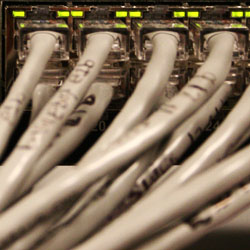
Published Rules
A fully standards-based network abides by a published set of rules, which specifies a recommended interface for serial digital transmissions. This includes the description of data format for transport and the method of transport.
The best part of a standards-based audio network is that any manufacturer can implement the format into their products without having to pay the often-expensive licensing fees of a proprietary solution.
This allows the use of “manufacturer A’s” reverb unit with “manufacturer B’s” digital console without the conversion to analog, resulting in a total system latency that is much lower than if a D/A and A/D conversion was necessary.
The most common standard is AES3, more often called the AES/EBU (Audio Engineering Society/European Broadcasting Union) standard. AES3 uses a 110-ohm shielded twisted pair cable to send two channels up to 300 feet. The standard allows up to a 24-bit resolution with no maximum sample rate.
Another standard developed by the AES is AES10, more commonly called MADI (Multichannel Audio Digital Interface).
MADI offers 64 channels at a 48 kHz sample rate and 32 channels at a 96 kHz sample rate with a resolution of up to 24 bits per channel. Transmission over a single 75-ohm coaxial cable has a limitation of 150 feet, but the use of fiber-optic cables can extend the length to two miles.
Other multichannel standards include ADAT Optical (ADI), Sony/Phillips Digital Interface (S/PDIF), and Tascam Digital Interface (TDIF). See Table 1.
The only latency added into standards-based digital audio distribution is the act of making the A/D and D/A conversions and any subsequent DSP that occurs. This is unlike some proprietary solutions that also require additional time to transcode and transport the data.
Viable and Affordable
There are a multitude of proprietary systems in the ever-evolving marketplace which use the standard IEEE 802.3 Ethernet protocols.
Ethernet is used because it’s relatively inexpensive, reliable, and the technology has been, and will continue to be, upgraded by the computer industry.
There was a time when 10baseT was the best thing going. Now, gigabit (100baseT) Ethernet has become viable and affordable.
The problem with Ethernet is that it is a non-deterministic system, meaning that the data will arrive when it feels like it.
However, several manufacturers have developed systems that make the arrival times very predictable and allow for the network to be synchronized with only a small margin of error.
For instance, one standard’s master unit regularly broadcasts beat packets onto the network either from its internal clock or an external master clock.
Other devices on the network which utilize said standard lock onto the arrival time of this packet and regenerate the clock locally. The error in clock delivery is ±1/4 sample period; this translates to about .005 ms at a 48 kHz sampling rate.
While digital seems to be the future of audio networks, it still requires attention to detail and proper setup.
Monitoring overall system latency and keeping a consistent sample rate and bit resolution are both new requirements for the digital age.
The answer to the question of what system is best for your situation is still the one that best meets your needs, which might be good old-fashioned analog.
Digital is just another hammer in the sound designer’s tool belt which can either drive the nail home if used correctly or smash a thumb if its requirements are ignored.
David A. McNell, CTS, is an AV engineer working in the Special Technologies Group of Newcomb & Boyd, Atlanta. He is a Certified Technology Specialist (CTS) and an EIT.

